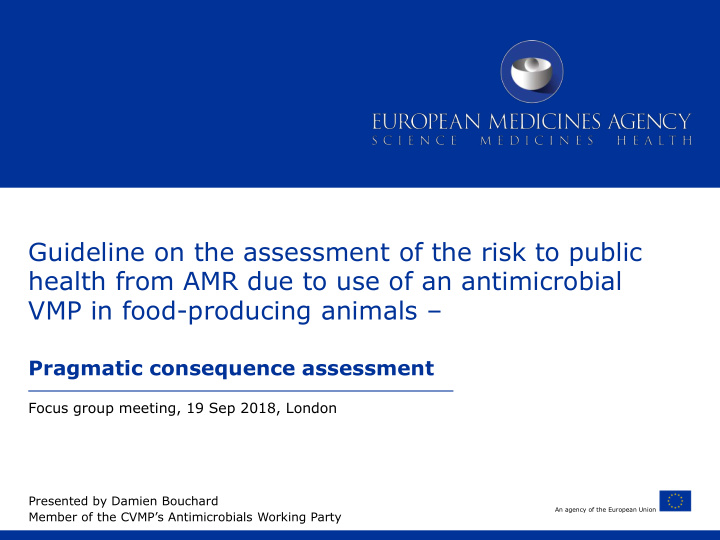



Guideline on the assessment of the risk to public health from AMR due to use of an antimicrobial VMP in food-producing animals – Pragmatic consequence assessment Focus group meeting, 19 Sep 2018, London Presented by Damien Bouchard An agency of the European Union Member of the CVMP’s Antimicrobials Working Party
Data requirements: 4. Consequence assessment This step addresses the potential consequences of exposure of humans to each of the hazard(s) in the EU and the severity and probability of the consequences occurring. 1 AMR risk assessment GL - Simplified consequence assessment
Consequence assessment: data requirements and guidance. A. Relative importance of the antimicrobial to human medicine = Source: WHO categorisation / ESAC database B. Dose-response relationships (where available) C. Consequences of AMR in human infections = Sources: The EU Summary Report on Trends and Sources of Zoonoses, Zoonotic Agents and Food-borne Outbreaks; European Surveillance System (TESSy), Scientific Opinions from BIOHAZ 2 AMR risk assessment GL - Simplified consequence assessment
Consequence assessment: data requirements and guidance. A discussion should be provided: the overall conclusion on the potential adverse health effects of exposure of humans to the hazard(s) + the severity and probability of those consequences. Proposed categories to be used: Very low: The antimicrobial is of very low importance in terms of the • frequency of use to treat a disease for which alternatives are commonly available. Low: The antimicrobial is of low to medium importance in terms of the • frequency of use to treat a disease for which the outcomes are more serious. Medium: The antimicrobial is of medium to high importance in terms of the • frequency of use to treat a disease for which the outcomes are more serious with impact on the individual and on healthcare services. High: The antimicrobial is a last resort treatment (or one of few alternatives) for • a disease for which the outcome of treatment failure is very severe. 3 AMR risk assessment GL - Simplified consequence assessment
Consequence assessment: Pragmatic approach Acknowledging the extent of the gaps in the data needed to perform the consequence assessment, an option is proposed for a simplified consequence assessment that would be based on the AMEG categorization for the antimicrobials substance and the extent of use of the AM class in human medicine. 4 AMR risk assessment GL - Simplified consequence assessment
Pragmatic approach AMEG categorisation Importance for human medicine Probability of resistance transfer 5 AMR risk assessment GL - Simplified consequence assessment
Pragmatic approach AMEG categorisation Importance for human medicine Probability of resistance transfer 6 AMR risk assessment GL - Simplified consequence assessment
Pragmatic approach AMEG categorisation Importance for human medicine Probability of resistance transfer 7 AMR risk assessment GL - Simplified consequence assessment
Pragmatic approach AMEG categorisation Importance for human medicine Probability of resistance transfer New mandate given to AMEG to revise the categorisation 8 AMR risk assessment GL - Simplified consequence assessment
Pragmatic approach Extent of use Consumption of antibacterials for systemic use DDD per 1000 inhabitants per day Based on data provbided courtesy of ESAC-Net 9 AMR risk assessment GL - Simplified consequence assessment
Pragmatic approach AMEG categorisation + Extent of use The ranking for the consequence is then derived according to the matrix: Extent of use in human medicine AMEG category Very low LOW MEDIUM HIGH 3 High High High High 2 High High High High 2/1 Low Medium Medium High 1 Very low Low Low Medium This table will be subject to revision and finalised after the AMEG scientific advice is completed. 10 AMR risk assessment GL - Simplified consequence assessment
Thank you for your attention Further information zoltan.kunsagi@ema.europa.eu European Medicines Agency 30 Churchill Place • Canary Wharf • London E14 5EU • United Kingdom Telephone +44 (0)20 3660 6000 Facsimile +44 (0)20 3660 5555 Send a question via our website www.ema.europa.eu/contact Follow us on @EMA_News
Recommend
More recommend